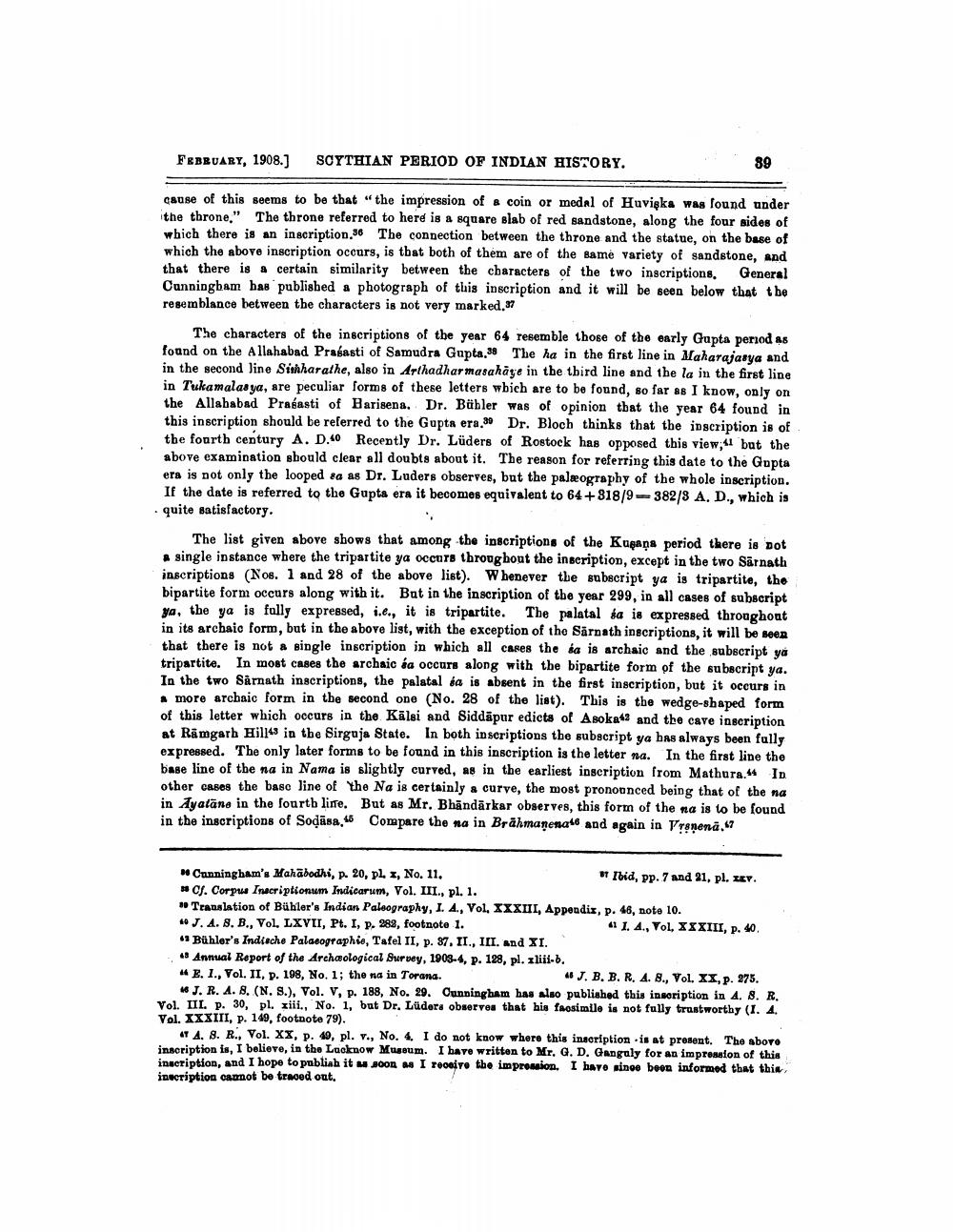________________
FEBRUARY, 1908.)
SCYTHIAN PERIOD OF INDIAN HISTORY.
99
cause of this seems to be that "the impression of a coin or medal of Huvieka was found under the throne." The throne referred to here is a square slab of red sandstone, along the four sides of which there is an inscription.36 The connection between the throne and the statue, on the base of which the above inscription occurs, is that both of them are of the same variety of sandstone, and that there is a certain similarity between the characters of the two inscriptions. General Cunningham has published a photograph of this inscription and it will be seen below that the resemblance between the characters is not very marked.37
The characters of the inscriptions of the year 64 resemble those of the early Gupta period as found on the Allahabad Prasasti of Samudra Gupta,38 The ha in the first line in Maharajasya and in the second line Sitharathe, also in Arthadharmasahaye in the third line and the la in the first line in Tukamalasya, are peculiar forms of these letters which are to be found, so far 88 I know, only on the Allahabad Prasasti of Harisena. Dr. Bühler was of opinion that the year 64 found in this inscription should be referred to the Gupta era.30 Dr. Bloch thinks that the inscription is of the fourth century A. D. Recently Dr. Lüders of Rostock has opposed this view, but the above examination should clear all doubts about it. The reason for referring this date to the Gupta era is not only the looped sa as Dr. Luders observes, but the palæography of the whole inscription. If the date is referred to the Gupta era it becomes equivalent to 64 + 818/
9 382/3 A, D., which is . quite satisfactory.
The list given above shows that among the inscriptions of the Kugapa period there is not single instance where the tripartite ya occurs throughout the inseription, except in the two Sārnath inscriptions Nos. 1 and 28 of the above list). Whenever the subscript ya is tripartite, the bipartite form occurs along with it. But in the inscription of the year 299, in all cases of subscript ya, the ya is fully expressed, i.e., it is tripartite. The palatal sa is expressed throughout in its archaic form, but in the above list, with the exception of the Sārnath inscriptions, it will be seer that there is not a single inscription in which all cases the ta is archaic and the subscript ya tripartite. In most cases the archaic éa occurs along with the bipartite form of the subscript ya. In the two Sarnath inscriptions, the palatal sa is absent in the first inscription, but it occurs in * more archaic form in the second one (No. 28 of the list). This is the wedge-shaped form of this letter which occurs in the Kālsi and Siddapur edicts of Asoka and the cave inscription at Ramgarh Hill in the Sirguja State. In both inscriptions the subscript ya bas always been fully expressed. The only later forms to be found in this inscription is the letter na. In the first line the base line of the na in Nama is slightly curved, as in the earliest inscription from Mathura. In other cases the base line of the Na is certainly & curve, the most pronounced being that of the na in Ayatāne in the fourth line. But as Mr. Bhāndārkar observes, this form of the na is to be found in the inscriptions of Sodāsa, 66 Compare the na in Brahmanenate and again in Vranena.
* Cunningham's Mahābodhi, p. 20, , No. 11.
* Ibid, pp. 7 and 21. pl. sxv. # Cf. Corpus Inscriptionum Indicarum, Vol. III., pl. 1. ** Translation of Bühler's Indian Paleography, I. A., Vol. XXXIII, Appendix, p. 46, note 10. 40 J. A. 8. B., Vol. LXVII, Pt. I, P. 282, footnote 1.
41. 4., Vol. XXXIII, p. 40. • Bühler's Indiache Palacographie, Tafel II, p. 37. II., III. and XI. 9 Annual Report of the Archaological Survey, 1908-4, p. 128, pl. Iliii-b. E. 1., vol. II, p. 198, No. 1; the na in Torana.
4 J. B. B. R. 4. 8., Vol. XX, p. 275. 46 J. R. 4. 8. (N. S.), Vol. V, p. 188, No. 29. Cunningham has also published this inscription in 4. 8. R. Vol. III. p. 30, pl. xiii., No. 1, but Dr. Lüdera observes that his facsimile is not fully trustworthy (I. 4. Vol. XXXIII, p. 149, footnote 79).
IT A. 8. R., Vol. XX, p. 40, pl. Y., No. 4. I do not know where this inscription is at present. The sboro inscription is, I believe, in the Lucknow Museum. I have written to Mr. G. D. Ganguly for an impression of this inscription, and I hope to publish it was soon as I receive the impronion. I havo singo boon informed that this inscription cannot be traced out,




